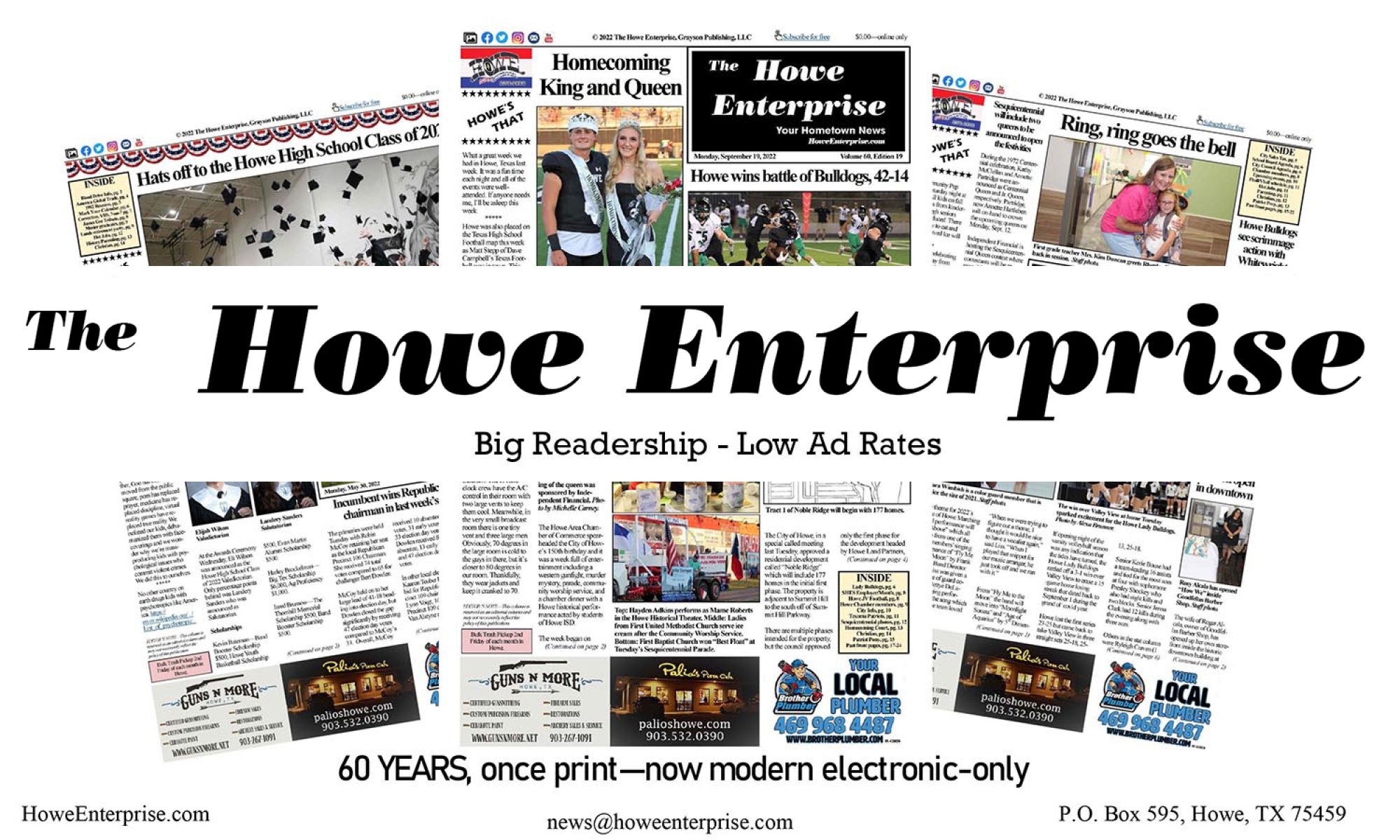57.38 Howe Enterprise February 3, 2020
57.37 Howe Enterprise January 27, 2020
57.36 Howe Enterprise January 20, 2020
57.35 Howe Enterprise January 13, 2020
Howe Youth Sports Association seeking board members for Howe Youth Football
Fill out my online form.
HTML Forms powered by Wufoo.
57.34 Howe Enterprise January 6, 2020
85-year-old man found dead in Grayson County Jail cell

On Dec. 30, 2019 at approximately 3:45 PM, 85-year-old Lonnie Morrison, Jr. was found unresponsive in his Grayson County jail cell. He was the only person in this cell. The onsite medical team was notified and started life-saving measures. Mr. Morrison was transported to a local hospital where he was pronounced dead.
In compliance with Texas Commission on Jail Standards the Texas Rangers Office is conducting an investigation into this matter. It is a standard operating procedure to have an outside agency conduct this type of investigation.
Mr. Morrison had been in Grayson County custody for approximately 26 days before his death.

57.33 Howe Enterprise December 30, 2019
District 5-3A-1 All-District Honors
| AWARD | PLAYER | SCHOOL | CLASS |
| Most Valuable Player | Cy Shope | Pottsboro | Sr. |
| Offensive Player of the year | Braden Plyler | Pottsboro | Jr. |
| Defensive player of the year | Zach Wideman | Pottsboro | Sr. |
| Zach Moncier | Van Alstyne | Sr. | |
| All Purpose player of the year | Brad Caldwell | Commerce | Sr. |
| Jalen Thornton | Howe | Jr. | |
| Newcomer of the Year | Jaden Mahan | Van Alstyne | Fr. |
| Austin Haley | Howe | Fr. | |
| Offensive Lineman of the year | Dan Graham | Pottsboro | Jr. |
| Defensive Lineman of the year | Silas Barr | Pottsboro | Jr. |
| Coaching Staff of the Year | Pottsboro | ||
| OFFENSE | |||
| 1st Team Quarterback | Luke Sheppard | Rains | Jr. |
| 2nd Team Quarterback | Quiad Williams | Lone Oak | Sr. |
| Tymothe Rosenthall | Van Alstyne | Sr. | |
| 1st Team Running backs (3) | Mason Songer | Rains | Jr. |
| Jake Carroll | Van Alstyne | Sr. | |
| Xzay Basham | Commerce | Jr. | |
| 2nd Team Running backs (3) | Dayton Dunbar | Commerce | Jr. |
| Brandon Williams | Howe | Sr. | |
| Mariano Rincon | Lone Oak | Fr. | |
| AWARD | PLAYER | SCHOOL | CLASS |
| 1st Team Receivers (5) | Luke Ratliff | Rains | Sr. |
| Drelin Davis | Van Alstyne | Sr. | |
| Nick Rhinehart | Bonham | Jr. | |
| Conner Smith | Commerce | Sr. | |
| Jack Kizer | Lone Oak | Sr. | |
| Ezra Fritts | Pottsboro | Sr. | |
| Titus Lyons | Pottsboro | Jr. | |
| 2nd Team Receivers (5) | Drake Hurley | Rains | Jr. |
| Cam Montgomery | Van Alstyne | Sr. | |
| Kolby Windon | Howe | Sr. | |
| Caden Harmon | Howe | Sr. | |
| Jasek Hooker | Pottsboro | Sr. | |
| Zach Talley | Pottsboro | Sr. | |
| Poppy Villegas | Rains | Sr. | |
| 1st Team Offensive Tackle (3) | Anthony Peak | Commerce | Sr. |
| Zack Isenberg | Lone Oak | So. | |
| Adrian Delacruz | Pottsboro | Sr. | |
| Hayden Buchanan | Rains | Jr. | |
| Jake Loganbill | Van Alstyne | Sr. | |
| 2nd Team Offensive Tackle (3) | Roy Gaffney | Commerce | Jr. |
| Jarron Ing | Howe | Sr. | |
| Anthony Wilson | Rains | Jr. | |
| Jacob Taylor | Van Alstyne | Sr. | |
| 1st Team Offensive Guard (2) | Hunter Fulton | Pottsboro | Sr. |
| Daniel Mendez | Rains | Jr. | |
| Anton Stapleton | Commerce | Jr. | |
| 2nd Team Offensive Guard (3) | Hunter Griffen | Van Alstyne | Sr. |
| AWARD | PLAYER | SCHOOL | CLASS |
| 1st Team Center (1) | Trevor Coon | Rains | Jr. |
| Jacob Kennedy | Bonham | Sr. | |
| 2nd Team Center (2) | Cade Morgan | Van Alstyne | Sr. |
| Taylor Kepley | Commerce | Sr. | |
| Gage Mauch | Lone Oak | So. | |
| 1st Team Kicker (1) | Andrew Balthrop | Rains | Jr. |
| Nick Rhinehart | Bonham | Jr. | |
| 2nd Team Kicker (2) | Rueben Casteneda | Commerce | Sr. |
| Kevin Flores | Howe | Jr. | |
| 1st Team Punter | Edgar Castillo | Commerce | Jr. |
| Jack Kizer | Lone Oak | Sr. | |
| Andrew Balthrop | Rains | Jr. | |
| DEFENSE | |||
| 1st Team Safety (2) | Brye Kelley | Rains | Sr. |
| Drelin Davis | Van Alstyne | Sr. | |
| 2nd Team Saftey (2) | Wade Nicholson | Commerce | Jr. |
| Layton Elvington | Howe | Sr. | |
| Jasek Hooker | Pottsboro | Sr. | |
| 1st Team Cornerbacks (2) | Tyler Farris | Pottsboro | Jr. |
| Tyler Mandrell | Rains | Sr. | |
| Cam Montgomery | Van Alstyne | Sr. | |
| Marco Delgado | Bonham | So. | |
| 2nd Team Cornerbacks (3) | Caden Harmon | Howe | Sr. |
| Connor Pilkilton | Pottsboro | Sr. | |
| Colt Rivera | Rains | Sr. | |
| Ethan Litzkow | Van Alstyne | Sr. | |
| AWARD | PLAYER | SCHOOL | CLASS |
| 1st Team Outside LB (3) | Jackson Lipscomb | Pottsboro | Jr. |
| Hunter Brussow | Howe | Sr. | |
| 2nd Team Outside LB (2) | Devon Jacks | Rains | Sr. |
| Dalton McCaslin | Van Alstyne | Sr. | |
| Brant Stuber | Bonham | Jr. | |
| 1st Team Inside LB (3) | Rayray Mares | Rains | Sr. |
| James Hinch | Rains | Jr. | |
| Aiden Straub | Bonham | Sr. | |
| Luke Porter | Bonham | Sr. | |
| Jonathon Helpenstell | Howe | Sr. | |
| Austin Cates | Pottsboro | Sr. | |
| 2nd Team Inside LB (2) | Kendrick Greer | Commerce | Fr. |
| Cole Morris | Lone Oak | Sr. | |
| 1st Team Defensive Line (5) | Hunter Griffin | Van Alstyne | Sr. |
| Henry Serrano | Commerce | So. | |
| Jackson Adkins | Howe | Jr. | |
| Steven Waldrip | Howe | Sr. | |
| Zack Isenberg | Lone Oak | So. | |
| Riley Deaton | Pottsboro | Sr. | |
| Hunter Fulton | Pottsboro | Sr. | |
| Donovon Throneberry | Rains | Jr. | |
| 2nd Team Defensive Line (5) | Jacob Gallardo | Van Alstyne | Jr. |
| Jacob Kennedy | Bonham | Sr. | |
| CJ Dunbar | Commerce | Jr. | |
| Anthony Cork | Commerce | Sr. | |
| Jarron Ing | Howe | Sr. | |
| Keatyn Eitelman | Pottsboro | Sr. | |
| Johnny Knighton | Rains | Sr. | |
| Colton Gable | Rains | Sr. |

